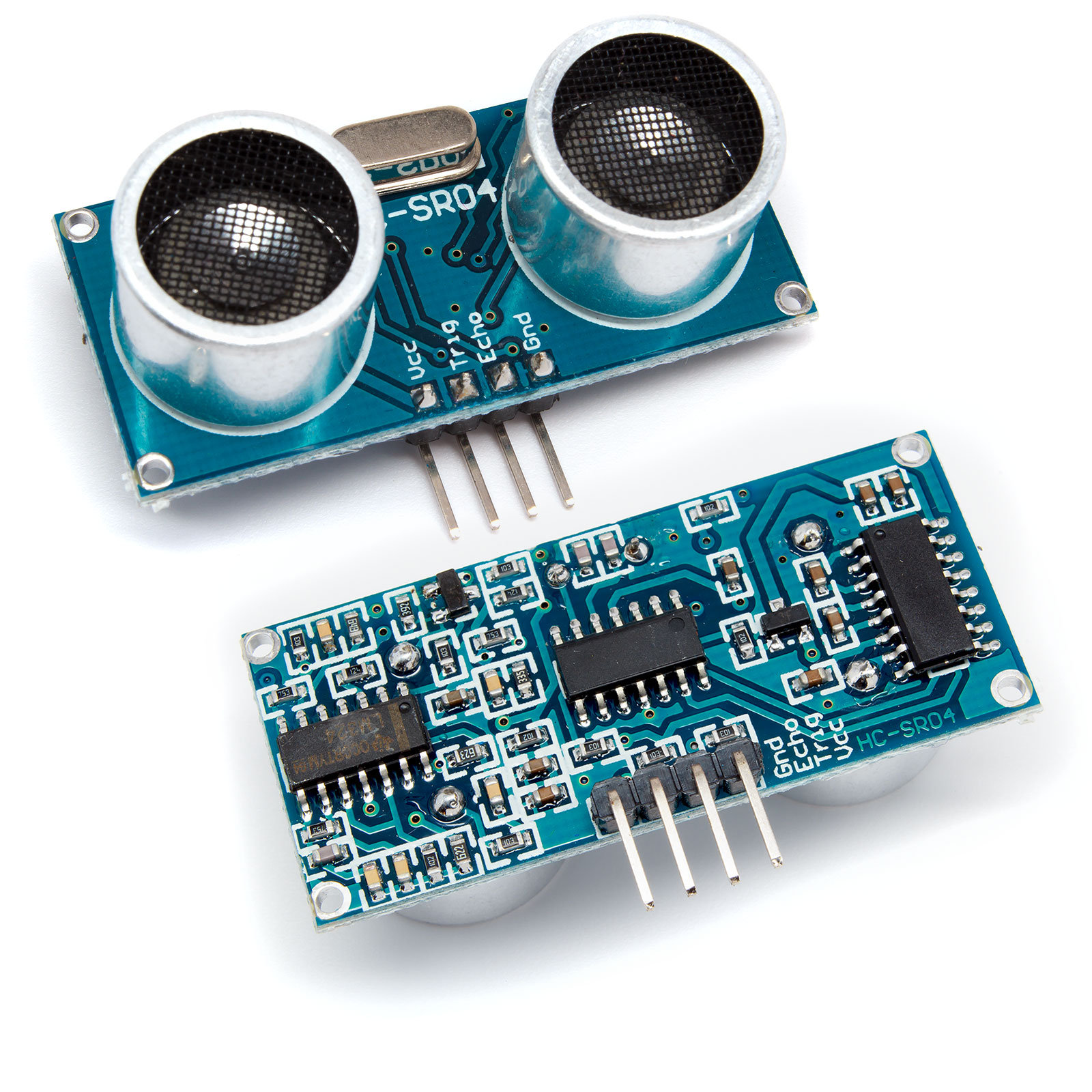Arduino communication library for the HC-SR04 ultrasonic sensor.
-
Simple usage
-
Advance usage:
- Global, Dynamic, Combined parameter specification
- Builder
-
Specify samples
- Specify temperature (Celsius, Fahrenheit)
- Specify measurement distance (Centimeters, Meters, Inches, Foot, Yards)
- Specify max distance (Centimeters, Meters, Inches, Foot, Yards)
- Specify response timeout (Milliseconds)
- Specify cooldowns (Milliseconds)
-
One & Two wire mode.
-
Error Statistics (Signal Timed Out Count, Response Timed Out Count, Max Distance Exceeded)
In the examples the HC-SR04 is used in one wire mode. The library supports one and two wires.
Copy the content of the src/hcsr04 folder and place them in your project.
#include <Arduino.h>
#include <SerialPrintF.h>
#include "hcsr04/HCSR04.h"
#define SERIAL_BAUD_RATE 9600
#define HCSR04_ONE_WIRE_PIN 9
HCSR04 hcsr04(HCSR04_ONE_WIRE_PIN);
void setup() {
Serial.begin(SERIAL_BAUD_RATE);
}
void loop() {
Measurement measurement = hcsr04.measure();
serial_printf(Serial,
"Distance: %2f %s, Valid Samples: %l/%i [Signal Timed Out Count: %i, Response Timed Out Count: %i, Max Distance Exceeded Count: %i, Response Cool Down: %o]\n",
measurement.getDistance(), getDistanceUnitAbbreviation(measurement.getDistanceUnit()),
measurement.getValidMeasurementsCount(),
measurement.getTakenSamples(),
measurement.getSignalTimedOutCount(),
measurement.getResponseTimedOutCount(),
measurement.getMaxDistanceExceededCount(),
measurement.getIsResponseCoolDownActive());
}#include <Arduino.h>
#include <SerialPrintF.h>
#include "hcsr04/HCSR04.h"
#define SERIAL_BAUD_RATE 9600
#define HCSR04_ONE_WIRE_PIN 9
HCSR04 hcsr04(HCSR04_ONE_WIRE_PIN);
void setup() {
Serial.begin(SERIAL_BAUD_RATE);
hcsr04.setDefaultSamples(5);
hcsr04.setDefaultTemperature(21.55, TemperatureUnit::CELSIUS);
hcsr04.setDefaultMaxDistance(1, DistanceUnit::METERS);
hcsr04.setDefaultMeasurementDistanceUnit(DistanceUnit::CENTIMETERS);
hcsr04.setDefaultResponseTimeoutMS(300);
hcsr04.setDefaultResponseTimeoutCoolDownMS(5000);
}
void loop() {
Measurement measurement = hcsr04.measure();
serial_printf(Serial,
"Distance: %2f %s, Valid Samples: %l/%i [Signal Timed Out Count: %i, Response Timed Out Count: %i, Max Distance Exceeded Count: %i, Response Cool Down: %o]\n",
measurement.getDistance(),
getDistanceUnitAbbreviation(measurement.getDistanceUnit()),
measurement.getValidMeasurementsCount(),
measurement.getTakenSamples(),
measurement.getSignalTimedOutCount(),
measurement.getResponseTimedOutCount(),
measurement.getMaxDistanceExceededCount(),
measurement.getIsResponseCoolDownActive());
}#include <Arduino.h>
#include <SerialPrintF.h>
#include "hcsr04/HCSR04.h"
#define SERIAL_BAUD_RATE 9600
#define HCSR04_ONE_WIRE_PIN 9
HCSR04 hcsr04(HCSR04_ONE_WIRE_PIN);
void setup() {
Serial.begin(SERIAL_BAUD_RATE);
}
void loop() {
Measurement measurement = hcsr04.measure(
MeasurementConfiguration::builder()
.withSamples(5)
.withTemperature(21.55,TemperatureUnit::CELSIUS)
.withMaxDistance(1,DistanceUnit::METERS)
.withMeasurementDistanceUnit(DistanceUnit::CENTIMETERS)
.withResponseTimeoutMS(300)
.withResponseTimeoutCoolDown(5000)
.build());
serial_printf(Serial,
"Distance: %2f %s, Valid Samples: %l/%i [Signal Timed Out Count: %i, Response Timed Out Count: %i, Max Distance Exceeded Count: %i, Response Cool Down: %o]\n",
measurement.getDistance(),
getDistanceUnitAbbreviation(measurement.getDistanceUnit()),
measurement.getValidMeasurementsCount(),
measurement.getTakenSamples(),
measurement.getSignalTimedOutCount(),
measurement.getResponseTimedOutCount(),
measurement.getMaxDistanceExceededCount(),
measurement.getIsResponseCoolDownActive());
}#include <Arduino.h>
#include <SerialPrintF.h>
#include "hcsr04/HCSR04.h"
#define SERIAL_BAUD_RATE 9600
#define HCSR04_ONE_WIRE_PIN 9
HCSR04 hcsr04(HCSR04_ONE_WIRE_PIN);
void setup() {
Serial.begin(SERIAL_BAUD_RATE);
hcsr04.setDefaultSamples(4);
hcsr04.setDefaultResponseTimeoutMS(250);
}
void loop() {
Measurement measurement = hcsr04.measure(
MeasurementConfiguration::builder()
.withSamples(5)
.withTemperature(21.55,TemperatureUnit::CELSIUS)
.withMaxDistance(1,DistanceUnit::METERS)
.withMeasurementDistanceUnit(DistanceUnit::CENTIMETERS)
.withResponseTimeoutMS(300)
.withResponseTimeoutCoolDown(5000)
.build());
serial_printf(Serial,
"Distance: %2f %s, Valid Samples: %l/%i [Signal Timed Out Count: %i, Response Timed Out Count: %i, Max Distance Exceeded Count: %i, Response Cool Down: %o]\n",
measurement.getDistance(),
getDistanceUnitAbbreviation(measurement.getDistanceUnit()),
measurement.getValidMeasurementsCount(),
measurement.getTakenSamples(),
measurement.getSignalTimedOutCount(),
measurement.getResponseTimedOutCount(),
measurement.getMaxDistanceExceededCount(),
measurement.getIsResponseCoolDownActive());
}- The idea behind the library is to give the user flexibility when using the library.
When measuring you can specify different configurations parameters for a measurement.
If a parameter is not specified in configuration of the measurement, then the one set at the begging will be used and even if he is not specific then the default ones will be used.
Each of the rest configuration parameters that you have not set for the measurement will come either from the ones that you have specified at the start or the default ones.
That creates a priority, for example:
- If samples is not set in the
MeasurementConfiguration::builder().withSamples(5).build()check the default valuehcsr04.setDefaultSamples(4);and even if the default value was not set get the one from the macro#define DEFAULT_SAMPLES 3
With that you can specify different parameters at the start of the program and then use them globally, but also have the ability to overwrite them.
How many times to take measurement. Then the returned distance will be the average of a valid measurements.
The maximum distance that is allowed. If a measurement's distance exceeds it, then the measurement is invalid.
The ambient temperature.
Increases the accuracy of the measurement, because the sound speed is dependent on temperature.
The maximum time to take a measurement.
If the time is exceeded then the measurement is invalid.
Indication when there is something wrong with the communication to the device eg: not connected
In what distance unit the measurement will be returned.
Let's say that you have a measurement in your program with 5 samples. If the HCSR04 is not connected, then there will be no samples, but you will lose time for example ~315 milliseconds on each loop.
To avoid that and you can try measuring after specific time again. That is where the cool downs come.
The cooldown will be activated, when all of the samples that have been measured have timed out. If a measurement fails again, then it will be activated again and so on.
The content in the brackets is their default value.
